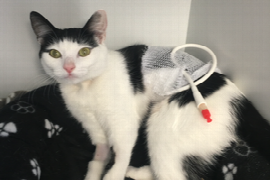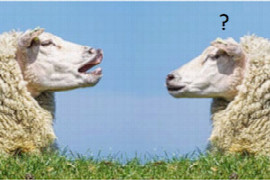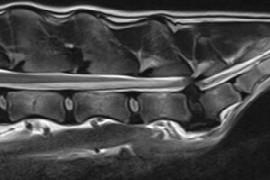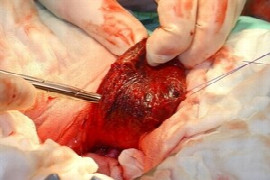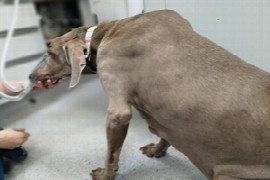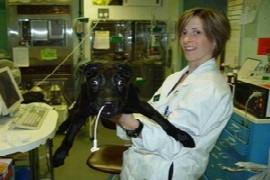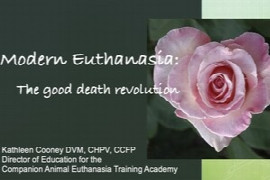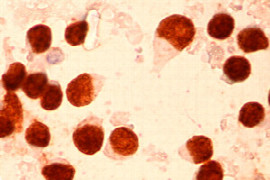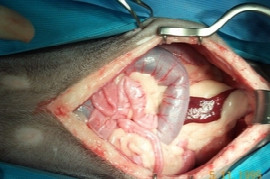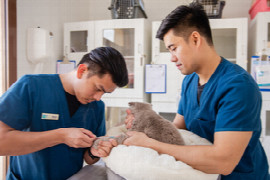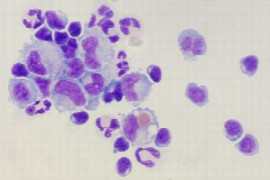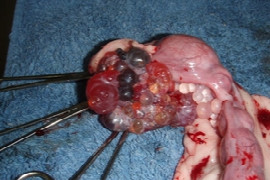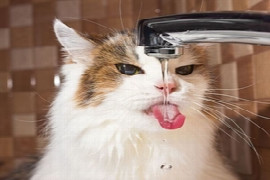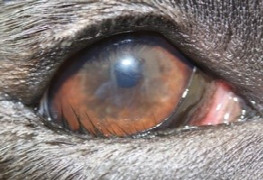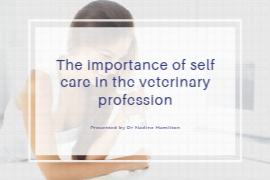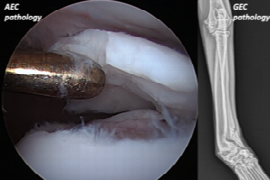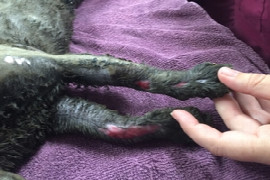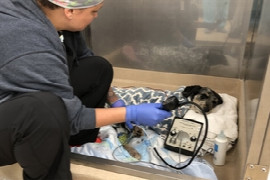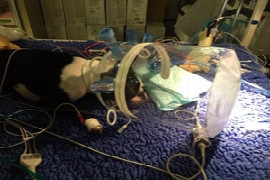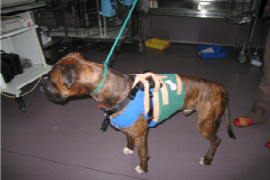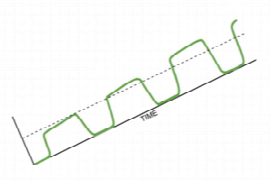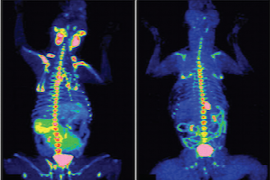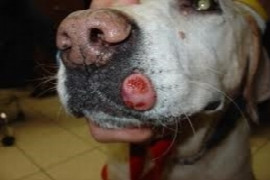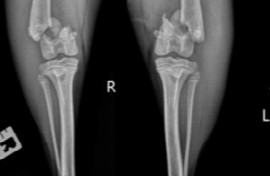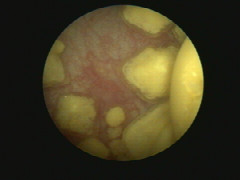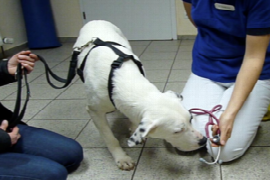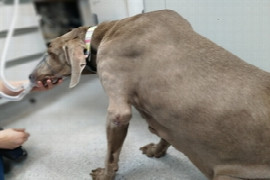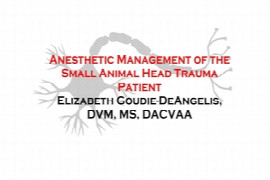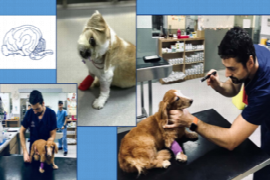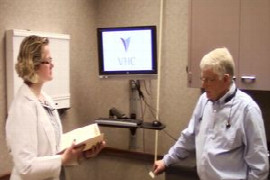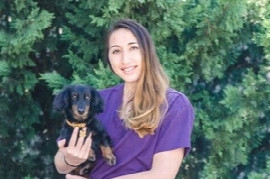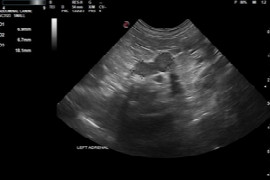Nursing the Hepatic Lipidosis Patient
Hepatic lipidosis is a common cause of acquired liver disease in cats. It is a multifactorial syndrome and factors such as anorexia, stress and concurrent disease are associated with the development of the condition. The veterinary nurse is heavily involved in managing the hepatic lipidosis patient, from assistance with diagnostic imaging and investigations, to administering prescribed treatment, implementing a nutritional plan and day-to-day monitoring and nursing care. This webinar will discuss the pathophysiology, diagnosis and treatment of hepatic lipidosis, as well as the vital role of the veterinary nurse in caring for these patients.
Duration:
1:00 h
Speaker:
Laura Rosewell
from 1
US$ 46.20
(incl. tax)
(incl. tax)
Say what?! Common mistakes German speakers make - from a veterinary medical perspective
We will cover common mistakes typically made by German speakers and how to correct them. We will relate how these common mistakes affect communication with colleagues and animal owners and impact upon being properly understood.
Duration:
0:41 h
Speaker:
Cindy L. Willheim
from 1
US$ 46.20
(incl. tax)
(incl. tax)
Lumbosacral Stenosis
This vet-webinar reviews the aetiology, diagnosis and management of degenerative lumbosacral stenosis. Lumbosacral stenosis occurs when soft tissue and/or bony changes impinge on the nerve roots or vasculature of the cauda equina. The impingement can be worsened in conjunction with abnormal motion of the lumbosacral joint. Lumbosacral stenosis occurs most frequently in middle-aged dogs of medium to large breed, and German Shepherd dogs are predisposed to this disease. Common signs are lumbosacral pain, lameness, pelvic limb weakness and ataxia, and urinary incontinence. Diagnosis is based on clinical features and imaging studies. Depending on the severity of the compression but about 50% of dogs respond well to conservative treatments. Decompressive surgery is effective in most patients.
Duration:
0:55 h
Speaker:
Dorothee Krainer
from 1
US$ 46.20
(incl. tax)
(incl. tax)
Surgery of the Urinary System: When, how and why to use cystotomy tubes.
In this webinar we will be discussing how to manage cases that require urinary diversion. This may be a blocked cat, urethral trauma, neurological disease, or palliative care for trigonal neoplasia. Understanding how to best manage these patients in the short and long term is essential to the overall success of treatment. Although urethral catheterisation is relatively simple, it can be challenging in some cases and it never allows us to assess the patient’s ability to urinate when it is still in place. In contrast, a cystotomy tube is predictable to place and allows long term management, including being able to assess voluntary urination without removal. We will discuss when, how and why to use cystotomy tubes so that this technique can be applied in a wide range of scenarios in general practice.
Duration:
0:49 h
Speaker:
Kat Crosse
from 1
US$ 46.20
(incl. tax)
(incl. tax)
Oxygen Therapy (for Nurses)
There are many conditions where a patient may require supplemented oxygen, for example, dyspnoea, shock, sepsis, SIRs and head trauma. This webinar will address the difference between hypoxaemia and hypoxia, as well as the methods of oxygen delivery available to each patients needs and the fraction of inspired oxygen each provides. Humidification of oxygen, oxygen toxicity and other complications of oxygen therapy will be reviewed. Finally there will be a comprehensive look at how to monitor successful oxygen therapy and the techniques/ equations used to assess the oxygenation and ventilation of the patient.
Duration:
0:40 h
Speaker:
Chloe Fay
from 1
US$ 46.20
(incl. tax)
(incl. tax)
The behavioural effects in pets with owners being asked to socially distance
“The pandemic has changed things for everyone. It has made everyone think about how we interact with pets, not only now but also in the new normal, whatever that may be. Veterinarians and veterinary staff deal with pets daily and recognise the signs of fear, anxiety and stress but when do these signs mean that that things are serious and what advice should you give? How can you make things better for everyone?”
Duration:
0:54 h
Speaker:
Kersti Seksel
from 1
US$ 46.20
(incl. tax)
(incl. tax)
Central Venous Pressure in the Veterinary Patient (for Nurses)
Central venous pressure (or CVP) monitoring has been used in veterinary medicine as a tool for monitoring cardiac function and managing fluid therapy. In critical patients and complex anaesthetics, the technique expands the availability of information we have for patient management and helps provide a more complete picture of how the cardiovascular system is operating in conjunction with other monitoring techniques. As veterinary nurses/technicians, is it important to understand when, how and why to use central lines for critical patients and the importance of central line care and maintenance post-operatively.
This webinar will discuss the use of CVP monitoring in small animal practice with an overview of placement and management of central lines, techniques for monitoring CVP, interpretation of CVP and its limitations. We will also cover some of the controversies with its use in human medicine and briefly touch on other uses for central lines in our critical patients. Being comfortable with CVP monitoring will provide benefits in monitoring those complicated anaesthetics in critical patients and confidence in helping to make correct management decisions for better patient outcomes.
Duration:
0:36 h
Speaker:
Cheryl MacPherson
from 1
US$ 46.20
(incl. tax)
(incl. tax)
We are all ears! Management strategies for otitis externa
Otitis externa is a commonly encountered condition in general practice and referral practice. Identifying the predisposing, primary and perpetuating factors associated with otitis externa is a key component in gaining control of this condition long term. This webinar will cover the...
Duration:
0:47 h
Speaker:
Danielle Hoolahan
from 1
US$ 46.20
(incl. tax)
(incl. tax)
Tetanus – treatment for the board stiff!
Tetanus is an uncommon condition in dogs (and an under- recognised one in cats) that poses an almost unique set of therapeutic challenges. Wound contamination with the eponymous Clostridia bacteria results in neurotoxicity causing spastic muscular paralysis, and can be frequently fatal in companion animals. Most of these patients require lots of nursing care, physiotherapy and interventional nutrition, as well as medical and surgical treatment for the causative infection.
This webinar will help you through some of the challenges in diagnosis and definitive treatment, as well as providing guidelines for the successful supportive care of these difficult patients. Tetanus can be a very curable disease, with the right support at the right time, and is often manageable in practice.
Duration:
1:14 h
Speaker:
Daniel Lewis
from 1
US$ 46.20
(incl. tax)
(incl. tax)
Pre-anaesthetic assessment of the small animal patient (for Nurses)
Anaesthesia is a vital tool in small animal practice to facilitate diagnostic, corrective and curative procedures. Principles of appropriate drug choices and techniques are paramount to reduce peri-anaesthetic complications. But how do we come to make these choices? Pre-anaesthetic assessment of the individual patient in respect to signalment, disease status and procedure is invaluable in making these decisions. Pertinent history, and thorough physical examinations are the cornerstone to guide further relevant testing. Risk assessments and the factors that influence these risks, need to be identified and remedied where possible, prior to anaesthesia. Diagnostic testing with respect to blood work, electrocardiograms, and imaging are point of care tools which can add significant information to assist in our quest for the most appropriate peri-anaesthetic plan.
Duration:
0:57 h
Speaker:
Louise Bass
from 1
US$ 46.20
(incl. tax)
(incl. tax)
Modern Euthanasia: The good death revolution (for Nurses)
Euthanasia is going through an evolution. It is changing for the better; techniques, protocols, pricing, and attitudes. Patients deserve the best, clients demand the best, and our veterinary teams want to deliver it. We will explore new trends in hospital euthanasia experiences, reinforce those oldie but goodie protocols, and even dive into the new concept of dysthanasia. Led by Dr. Kathleen Cooney, founder and director of education for the Companion Animal Euthanasia Training Academy, this webinar will become the spark to modernize your euthanasia appointments.
Duration:
0:49 h
Speaker:
Kathleen Cooney
from 1
US$ 46.20
(incl. tax)
(incl. tax)
Advanced diagnostics in canine and feline lymphoma.
So you have a diagnosis of lymphoma in your small animal patient. What next? Classification of lymphoma is increasingly important for both prognostic and therapeutic decision making. This webinar will discuss diagnostic options to optimise the diagnostic process in your patient. Modalities discussed will include immunocytochemistry, immunohistochemistry, flow cytometry and PARR.
Duration:
0:50 h
Speaker:
Sue Jaensch
from 1
US$ 46.20
(incl. tax)
(incl. tax)
Resilience and Wellbeing Practices for Veterinary Nurses
The experience of stress is a personal one, and no two people will experience situations the same way. An event at work that could be considered a major stressful event for one nurse, may be seen by others as energising and challenging.
This webinar will explore evidence-based practices for developing resilience, and subsequently, greater wellbeing as a veterinary nurse. Topics include:
• Developing emotional insight, and self-awareness skills
• Personal resilience-building and wellbeing practices
• Practical strategies for handling difficult situations at work
Duration:
0:59 h
Speaker:
Rosie Overfield
from 1
US$ 46.20
(incl. tax)
(incl. tax)
Avoid the “Peak and Shriek” - Getting the most out of your exploratory laparotomies.
In this lecture, Charles will be presenting a systematic approach to the abdominal exploration in dogs and cats, concentrating on indications, what to look for when you’re in the abdomen and what to do when you find abnormalities. He will also discuss biopsy techniques and some tricks for intestinal resection and anastomosis.
Duration:
0:41 h
Speaker:
Charles Kuntz
from 1
US$ 46.20
(incl. tax)
(incl. tax)
Workplace Wellbeing and Managing Shift-Work
Numerous research has shown shift workers are prone to various chronic health complaints including gastrointestinal complaints, obesity, insulin resistance, cardiovascular disease, mental health disorders, depleted immune systems – to name a few. This stems largely from ongoing sleep deprivation and disruption to the sleep/wake cycle, along with subsequent misalignment of biological circadian rhythms which often induces fatigue, leading to poor dietary and lifestyle habits.
In this webinar, Audra Starkey will explore:
- Why sleep prioritization is critical for anyone working 24/7
- Strategies to support the parasympathetic nervous system to encourage better sleep
- The influence of chrononutrition in the management of shift work wellness
- Shift work nutrition – eating to support more energy, better digestive health and weight regulation
Duration:
0:59 h
Speaker:
Audra Starkey
from 1
US$ 46.20
(incl. tax)
(incl. tax)
Tips for Creating a Cat Friendly Environment in the Veterinary Emergency Room and Critical Care Setting
We as veterinarians are becoming more and more aware of the impact that a veterinary visit can have on the mental and emotional health of our patients. Cats seem to be particularly affected by leaving their known environments and entering into a new environment that can hold a multitude of unknown and unpleasant stressors. Imagine how heightened the perception of these stressors may be in an emergency or critical care setting. In this webinar, we will look at why it is so important to manage feline stress in the above mentioned settings and discuss easy to implement and practical strategies for the hospital, emergency room and critical care environment in order to improve recovery and outcome as well as create a safer and more pleasurable workplace for the veterinary team.
Duration:
0:56 h
Speaker:
Katrin Jahn
from 1
US$ 46.20
(incl. tax)
(incl. tax)
CSF evaluation - Cytology and Infectious Disease Diagnostics
Evaluation of CSF is an important diagnostic tool for assessment of patients displaying neurological abnormalities. Basic cytological evaluation of CSF includes determination of the total and differential leukocyte counts and protein concentration. In addition, other cytological abnormalities including atypical or neoplastic cells, infectious agents or evidence of haemorrhage may be identified. Pre-analytic variables, clinical signs and species variations must be taken into consideration when interpreting cytological findings. Characterising the type of inflammatory response can help to clarify the underlying pathological processes. Identification of infectious agents can be achieved using a number of methodologies and is a vital component of accurate diagnosis and treatment of neurological disease.
Duration:
0:47 h
Speaker:
Leanne Twomey
from 1
US$ 46.20
(incl. tax)
(incl. tax)
Pyometra in Small Animals
With increasing population of dogs being entire for longer, and the desire to treat medically rather than surgically performing an ovariohysterectomy, pyometra in small animal practice is becoming a commonly encountered problem. Here we review the medical and surgical options available for this disease.
Duration:
1:02 h
Speaker:
Xavier Schneider
from 1
US$ 46.20
(incl. tax)
(incl. tax)
FLUTD – Is it all about nutrition - for Nurses
Urinary tract disorders in cats is a truly multifactorial issue. Good history taking, including nutritional and behavioural, is required in order to give the best recommendations for the cat. Nutrition plays an important element of this, but it isn’t just about what the cat eats, but how the food is presented and feeding behaviours that impact on the cat.
The webinar will look at nutrients in the diet and how these impact on cats with FLUTD, but also feeding behaviour. We will look at how we feed cats plays a much larger role in FLUTD, in how it influences stress levels and potential interactions with other cats in the household.
We will also look at how obesity and weight loss diets effects cats with FLUTD.
Duration:
0:58 h
Speaker:
Nicola Lakeman
from 1
US$ 46.20
(incl. tax)
(incl. tax)
Issues with eyelids
Diseases affecting the eyelids are frequently encountered in small animal practice, affecting both dogs and cats. We will briefly consider the anatomy and function of the eyelids before looking in more detail at medical and surgical conditions. With the former it is important to remember that eyelid disease can sometimes be part of a generalised condition – such as atopy, or can be secondary to another eye disease – blepharitis as an extension from a bacterial conjunctivitis for example. Conditions such as entropion and ectropion might require surgical correction and we will see examples of these with tips for how to achieve the best outcome for the patient – the aim is always to restore normal function with minimal scarring. A correct diagnosis and meticulous attention to detail is required to attain this. Other common conditions such as eyelid tumours and distichiasis will be mentioned, and we will finish up with a few complications - and how to avoid them!
Duration:
1:05 h
Speaker:
Sally Turner
from 1
US$ 46.20
(incl. tax)
(incl. tax)
The importance of self-care in the veterinary profession (for Nurses)
The veterinary profession has a high rate of burnout and suicide, to which many factors contribute. This webinar will look at what research has shown to be the top five factors affecting veterinary professionals, and what can be done about it. It will also address the importance of good nutrition, exercise, sleep hygiene, as well as why self-care should be a priority to try and combat the often negative side-effects of working within the veterinary industry.
Duration:
1:02 h
Speaker:
Nadine Hamilton
from 1
US$ 46.20
(incl. tax)
(incl. tax)
Canine Epiphyseal Disease
The epiphysis is located at either end of long bones and is evident within the fetus approximately four weeks post conception. During growth, the epiphysis is comprised of specialized cartilage, including articular epiphyseal cartilage (AEC) and growth plate epiphyseal cartilage (GEC), together accounting for longitudinal growth of long bones. In maturity, most of the epiphyseal cartilage is replaced with trabecular bone, encased in a thin shell of cortical bone with hyaline cartilage persisting at the joint surface.
Epiphyseal pathology sustained during growth can have profound lifelong consequence. This webinar reviews common epiphyseal pathologies, including articular and growth plate osteochondrosis and epiphyseal trauma. A focus on diagnosis, treatment and expected outcomes with practical tips and tricks for use in your practice is presented.
Duration:
1:05 h
Speaker:
Ricky Cashmore
from 1
US$ 46.20
(incl. tax)
(incl. tax)
Fire Related Injuries (for Nurses)
In this webinar we will discuss the care of fire related injuries. A short overview of skin layers and degree of burn injuries will be discussed. We will cover triage and first aid of fire victims, respiratory emergencies such as smoke inhalation and carbon monoxide poisoning, wound management both acute and ongoing. The importance of nutrition and analgesia as well as shock and fluid therapy in these cases will also be discussed.
Duration:
1:10 h
Speaker:
Kate Tinney
from 1
US$ 46.20
(incl. tax)
(incl. tax)
Blood Pressure Monitoring for Veterinary Technicians and Nurses
A patient's blood pressure gives the nursing team valuable information about patient perfusion, fluid balance, and disease status. Are you confident understanding what blood pressure readings mean? Are you comfortable both setting up and interpreting direct arterial blood pressure monitoring? How can you troubleshoot and treat both hyper and hypotension? Are you aware of the disease processes that can change blood pressure? The webinar will answer all of those questions and more!
Duration:
0:51 h
Speaker:
Megan Brashear
from 1
US$ 46.20
(incl. tax)
(incl. tax)
Dealing with Imposter Syndrome
If you are completely honest with yourself, do you believe your failings are all your own fault, but your successes are pure good luck or a fluke? Are you forever wondering when the ‘fraud police’ are going to come and expose you for being a phony? Would you believe you aren’t alone? If you have ever felt like you didn’t belong somewhere or that your colleagues, friends, and associates are going to discover you are a phony and fraud and that you really don’t deserve the success, then you are not alone. These feelings are referred to as ‘imposter phenomenon’ or ‘imposter syndrome’ and it is estimated that at some point in life, around 70% of people will experience these feelings. Imposter syndrome affects a wide range of people from all aspects of life and this webinar will take a deeper look into the causes, symptoms, and ways you can deal with it.
Duration:
0:53 h
Speaker:
Nadine Hamilton
from 1
US$ 46.20
(incl. tax)
(incl. tax)
Mechanical Ventilation: The Basics
Mechanical ventilation is becoming a common therapeutic tool in veterinary medicine. Mechanical ventilation is often necessary in cases of hypoxic or hypercapnic respiratory failure, shock, coma, or cardiac arrest. In this seminar, we will discuss the mechanics of ventilation, the different ventilatory modes (pressure and volume controlled), their strengths, limitations, similarities and differences, we will also discuss their indications, and we will learn how to set up and adjust the setting for our patients. This seminar is centred around the concept of lung-protection and the open-lung theory.
Finally, we will use a couple of ventilator models as example for the configuration setting up.
This is a dynamic seminar with great and practical videos that will help you understand what is happening in the lungs when we program certain parameters in the ventilator. Finally, we will discuss about the patient weaning from the ventilator and the best strategies to achieve a positive outcome in these patients.
Duration:
1:01 h
Speaker:
Fernando Martinez-Taboada
from 1
US$ 46.20
(incl. tax)
(incl. tax)
An Update on Socialisation: What you need your clients to know
Socialisation has become all-important to ensure that a puppy grows up to be a healthy adult dog. If it is not done right, then the dog is ruined! But is this really true? A lack of socialization is blamed for all types of behaviour problems of dogs - but is this really accurate?
Socialisation is important for the healthy development of all youngsters, not just dogs. Even humans get socialized! It is more than just exposing the young animal to new experiences. The emphasis of exposure to novelty has overshadowed the importance of the caregiver to successful socialization. We will explore what it means to socialize a dog, what puppy breeders, puppy walkers and puppy owners need to be doing to help their puppy adapt to life with people (it is much easier than we think!). How the puppy adapts to learning about the wider world can help identify developmental problems and mental health disorders allowing early interventions. A well socialized animal makes the job of the veterinarians and veterinary staff easier as the animal is comfortable with meeting new people and learning new things. So advising your clients correctly helps them help their puppy which ultimately helps you do your job better!
Duration:
0:43 h
Speaker:
Jacqui Ley
from 1
US$ 46.20
(incl. tax)
(incl. tax)
Canine Dilated Cardiomyopathy
This webinar will discuss the pathophysiology of canine DCM and the common causes, diagnosis and treatment of dilated cardiomyopathy (DCM) in dogs. Nutritional DCM will be discussed as will differentiating degenerative mitral valve disease from DCM in large breed dogs.
Duration:
1:01 h
Speaker:
Richard Woolley
from 1
US$ 46.20
(incl. tax)
(incl. tax)
Special Needs of Geriatric Patients (for Nurses)
In recent years, small animal veterinary medicine has known major improvements in knowledge and quality of care, following the progress of human medicine. Our pet population is aging, revealing some conditions previously poorly recognised. Thus veterinary professionals are faced with new challenges. We need to study how our pets are aging, which structures are affected, and what physiological and pathological mechanisms are at play. Interestingly, dogs and cats, because they live alongside their owner, share the same environment, but have a shorter lifespan, can be good models for some human conditions such as Alzheimer’s disease, obesity and osteoarthritis.
Pet owners are keen to look after their pets for as long as possible, with a major emphasis on maintaining a good quality of life and avoiding pain. We will discuss how we can be with them every step of the way, to provide support and guidance, in all aspects of old age management: pain management, preventative treatments, environmental adaptations, nutritional support and so on. Because looking after our aging pets can give us an insight into how we, as humans, age. So that we all age well, together.
Duration:
0:49 h
Speaker:
Mathilde Granger
from 1
US$ 46.20
(incl. tax)
(incl. tax)
Capnography (for Nurses)
General anaesthesia carries an inherent risk for every patient, as unexpected cardiovascular and respiratory side effects can always occur. Therefore, monitoring anaesthesia is extremely important and should mainly focus on anaesthetic depth, cardiovascular and respiratory function.
Capnometry provides real time information on respiratory rate, end-tidal and inspired carbon dioxide values. From these data the anaesthetist can extrapolate information on cardiac output, depth of anaesthesia and breathing systems faults.
This webinar will guide you in the interpretation and understanding of capnography, as this is the most important monitoring tool available in small animal practice, and the person interpreting the information has a central role in the monitoring process.
Duration:
0:49 h
Speaker:
Clara Rigotti
from 1
US$ 46.20
(incl. tax)
(incl. tax)
Management of Status Epilepticus
Seizures are a common neurological disease in general practice. Often, patients can present in an emergency situation such as status epilepticus. This presentation aims to provide a good understanding of the pathophysiology of seizures, the initial emergency management of status epilepticus, a step-wise approach to ongoing treatment as well as the basic diagnostics of a patient with seizures.
Duration:
0:43 h
Speaker:
Hannah Kwong
from 1
US$ 46.20
(incl. tax)
(incl. tax)
Staging the Oncology Patient
Staging is one of the most important components of oncology case management. It involves determining the extent of local disease along with the presence or absence of regional or distant metastasis. The results of staging are used to give more accurate and informed treatment options along with prognostic information for each oncology patient. Some of the biggest challenges in staging is to consider how much staging is required for each case, which are the most appropriate tests, and if the results of these tests will impact treatment options and prognosis. I will discuss this information in a case-based and evidence-based approach, focusing on some of the more common cancers including canine mast cell tumours, lymphoma, oral tumours and apocrine gland anal sac adenocarcinomas.
Duration:
0:57 h
Speaker:
Laura Brockley
from 1
US$ 46.20
(incl. tax)
(incl. tax)
Coping in the COVID-19 Crisis
Covid-19 is testing us at home, and it is testing us at work. Come along to this webinar for support, encouragement and suggestions on how to stay mentally well when the world is going crazy around us.
Duration:
1:09 h
Speaker:
Cathy Warburton
from 1
US$ 46.20
(incl. tax)
(incl. tax)
Exam Room GPS: Using Signposts to Direct the Flow of Conversation
As veterinarians, we often see complicated cases. Patients may present to us with complex histories. Patients may present to us with a multitude of related or unrelated clinical signs. Clients may have more than one concern. We may or may not be able to address every concern at every visit.
All of these situations would potentially benefit from a roadmap. Mapping out the consultation is a communication skill that provides the sense of direction that is otherwise all too often lacking from the examination room. Mapping out the consultation is sometimes referred to as signposting. What mapping out the consultation means is that we verbally provide structure. We acknowledge openly where the conversation is headed, what we are choosing to discuss now, versus that which we will discuss later.
Just like a compass tells you which direction you’re facing, a consultation map tells the client the order in which consultation events will happen.
This webinar will introduce the communication skill of signposting and highlight how its use may be incorporated into clinical practice in a way that builds structure into the veterinary-client relationship.
Duration:
0:42 h
Speaker:
Ryane Englar
from 1
US$ 46.20
(incl. tax)
(incl. tax)
Intervertebral Disc Herniation (for Nurses)
It's 5pm on a Friday evening, kits are wrapped, theatre has been cleaned and everything is calm. Then…the phone rings. A non-ambulatory dachshund is on its way down… Everyone scrambles. Where is the CT tech? Is the sugairtome sterile?
Spinal patients can be some of the most challenging and yet most rewarding patients for Veterinary Nurses. We will answer the what, why and how of IVDD to better prepare you for these cases. From the 5pm Friday admit to the first steps post-surgery or the medically managed patient, this webinar will cover admission to discharge, the disease itself and treatment options both surgical and medical, husbandry and how nurses can ensure the best outcomes for their patients and owners.
Duration:
0:36 h
Speaker:
Paige Taylor
from 1
US$ 46.20
(incl. tax)
(incl. tax)
Using positive psychology to maintain and enhance well-being (for Nurses)
Positive psychology is a relatively new approach to the field of psychology where practising psychologists can help people achieve their maximum potential, without the individual necessarily having any clinical symptomatology. It is an important step in the era of psychology that takes the focus off what is wrong with people (or the disease model), and instead focuses on what is right with people. It is not about positive thinking, and it does not assume all other psychology is 'negative'. It is referred to as a branch of applied psychology that essentially considers people’s character strengths, and builds on those strengths to enhance a healthy and balanced lifestyle. Basically, it looks at what is “right”, as opposed to the traditional clinical approach that focuses on what is “wrong” (with ourselves, our organisations, our environment etc.). It also investigates what makes life worth living and how we can live the good life, and uses five pillars referred to as PERMA.
Duration:
0:52 h
Speaker:
Nadine Hamilton
from 1
US$ 46.20
(incl. tax)
(incl. tax)
Canine Mast Cell Tumours
Canine mast cell tumours are common in general practice. The diagnosis is usually straightforward by means of fine needle aspiration; however, management can be challenging due to the variable behaviour ranging from locally infiltrating lesions to aggressive mast cell tumours metastasising to the liver and spleen. As a consequence, outcomes range from weeks to years. The aim of the webinar is to focus on the use of prognostic factors to predict the behaviour of mast cell tumours and to guide management of each individual case. Once the extent of disease and likely prognosis has been established, a plethora of treatment options need to be considered including surgery, radiation therapy, chemotherapy, targeted therapy, palliative supportive care as sole or multi-modal therapy. Dogs with a good prognosis should be offered treatment options aimed at long term control, whereas the focus for dogs with a poor prognosis might need to be palliative. The second part of the webinar is focused on highlighting when to consider which treatment options.
Duration:
0:43 h
Speaker:
Evi Pecceu
from 1
US$ 46.20
(incl. tax)
(incl. tax)
Fracture classification, acute management and decision making
This webinar aims to improve the confidence of clinicians when presented with a patient that has suffered a fracture injury - mostly discussing appendicular fractures but also touching on axial fractures as well. We will cover the various fracture classification schemes and how the classification can influence the treatment course for the patient, including immediate stabilisation of the patient and management of the fracture site. We will then discuss decision making schemes for treatment of the fracture, as well as delving into important prognostic factors that may need to be addressed with owners.
Duration:
0:37 h
Speaker:
Kathryn Duncan
from 1
US$ 46.20
(incl. tax)
(incl. tax)
Practical tips for common urinary tract disorders
I hope to provide some practical tips on how to manage a few common urinary tract disorders. This will predominantly focus on urolithiasis in the lower urinary tract, including predicting stone type, treatment options (both dissolution and removal techniques) and preventive measures. I will introduce obstructive diseases in the upper urinary tract (i.e., ureteral obstruction), some medical options and then more advanced ‘bypass’ techniques. The use of antibiotics in urinary tract infections will be touched on, particularly to highlight good antimicrobial stewardship. And finally, a brief mention of two uncommon disorders that are often not recognised in veterinary practice, both idiopathic renal haematuria and reflex dyssynergia.
Duration:
0:52 h
Speaker:
Karina Graham
from 1
US$ 46.20
(incl. tax)
(incl. tax)
Medical training for dogs and cats - making the vet-visit less stressful for everyone
Visits to the vet can become stressful to the animal, the owners and the staff. Training the animal beforehand to stay relaxed and calm in the practice, and during manipulation, examination and treatment is an investment in the future. Results from examination are more reliable and allow a sounder diagnosis, when coming from a relaxed as possible animal. The owner will be calm and happy, this will increase the chance they will visit the practice again and the risk for getting bitten is reduced. This webinar will show some general principles for medical training of dogs and cats and how to apply them practically.
Duration:
0:55 h
Speaker:
Barbara Schöning
from 1
US$ 46.20
(incl. tax)
(incl. tax)
Unconditional Positive Regard
Unconditional positive regard is a concept that was initially coined by Carl Rogers, a leader in the field of human mental health. The practice of unconditional positive regard in veterinary medicine suggests that the clinician approaches each client as an individual. Clients are valued and accepted for who they are rather than held to standards that they are incapable of meeting.
The intent behind unconditional positive regard is to transform the examination room into a safe zone, where clients can feel free to be themselves, ask questions, and air concerns. Even patients that are so-called “difficult” should not be labeled as such. Instead, the clinician should focus on shared common ground:
• What do both individuals want to achieve?
• How can they work together to achieve it?
This webinar will introduce the communication skill of regard and highlight how its use may be incorporated into clinical practice in a way that builds the veterinary-client relationship.
Duration:
1:01 h
Speaker:
Ryane Englar
from 1
US$ 46.20
(incl. tax)
(incl. tax)
Cardiac Emergencies (for Nurses)
Cardiac emergencies require urgent attention, and delay of treatment to these patients may cause fatalities. Understanding how the condition will affect the patient is key to understanding treatment efficacy and the importance of the nurse’s role within the management of these patients.
This webinar will take an in-depth look at emergency management and treatment of common cardiac emergencies that present to the ER. Specific topics will include congestive heart failure, arrhythmia's, and pericardial effusion. During this one-hour session, top tips and deeper understanding of pathophysiology, clinical symptoms, treatment and nursing considerations will be addressed. A comprehensive focus on ECG interpretation and introduction to ultrasound techniques through case studies will help the nurse with case management.
Duration:
0:54 h
Speaker:
Chloe Fay
from 1
US$ 46.20
(incl. tax)
(incl. tax)
Anesthetic Management of the Head Trauma Patient for Veterinary Nurses
In this webinar, attendees will learn the pathophysiology of an increased intracranial pressure; in particular increased intracranial pressure secondary to traumatic brain injury. Further, they will learn strategies to ensure optimal perianesthetic care for these patients is achieved.
Increased intracranial pressure is, unfortunately, not uncommon in the veterinary field. Whether secondary to traumatic brain injury, intracranial lesion, or cerebral ischemia, these patients offer a challenging management picture particularly when general anesthesia is required. For many of these pets, general anesthesia and/or sedation is needed for imaging and diagnostics as well as supportive care (e.g. mechanical ventilation). Without general anesthesia these patients have an increased risk of morbidity and mortality, this is even more of a risk in the perianesthetic period.
It is important that not only are the appropriate steps undertaken to ensure appropriate anesthetic management but that other comorbidities that can be present with trauma, vascular events, or intracranial lesions are considered and treated as well.
Management of these patients can be complicated but does not need to be intimidating. By considering and treating the pet for its pathologies we can minimize the adverse effects of anesthetic agents while still ensuring that the best level of diagnostics and care can be performed safely.
Duration:
0:41 h
Speaker:
Elizabeth Goudie-DeAngelis
from 1
US$ 46.20
(incl. tax)
(incl. tax)
The neurological examination of small animals
Whether you are a veterinarian or a human physician, the neurological examination is the corner stone of the neurology consultation. It has been the case since the work of Pr Charcot who is called the father of modern neurology.
The concept behind it is that accurate neuroanatomical knowledge allows to interpret the clinical findings which ultimately translate into a neurolocalisation. Accurate neurolocalisation does at least half of the work of the neurologists. It allows appropriate choice of tests and almost always significantly narrows down the list of differential diagnoses.
The neurological examination implies good understanding of the basic functional neuroanatomy, method and some experience.
Duration:
0:59 h
Speaker:
Matthias Le Chevoir
from 1
US$ 46.20
(incl. tax)
(incl. tax)
Transparency in the Exam Room
Transparency is a buzzword in human healthcare that emerged nearly two decades ago, when, in 1999, the Institute of Medicine released the controversial report, To Err is Human. This report estimated that 44,000-98,000 people die every year in the United States because of preventable medical errors. The publication concluded that medicine is imperfect, but can be improved when dialogue is initiated about how to reduce errors.
Transparency implies full disclosure and open communication, even when the topic makes the provider vulnerable. For example, transparency requires that the provider be truthful about a medical error. This creates an ethical dilemma for the provider, who may feel morally obligated to share, yet fear retribution.
Medical mistakes are not the only circumstance in which transparency may be warranted or desired. This webinar will introduce the communication skill of transparency and highlight how its use may be incorporated into clinical practice in a way that builds the veterinary-client relationship.
Duration:
0:58 h
Speaker:
Ryane Englar
from 1
US$ 46.20
(incl. tax)
(incl. tax)
Wound Management and Reconstructive Surgery in Dogs and Cats
Not all wounds are created equal. Management and closure of wounds whether traumatic or surgically created (following mass removal for example) relies on a sound understanding of principles of wound healing and relevant patient and wound characteristics that can influence outcome. This webinar summarises and highlights key aspects of wound management and reconstructive surgery in dogs and cats with attention to relevant background principles of wound healing as well as clinical tips and tricks for practice. Areas to be covered include an overview of wound healing and factors affecting healing, methods of primary wound closure, open wound management and reconstructive methods including tension relieving techniques, skin flaps and skin grafts.
Duration:
0:57 h
Speaker:
Stephanie Colthurst
from 1
US$ 46.20
(incl. tax)
(incl. tax)
Dangers of Hypothermia (for Nurses)
Perioperative hypothermia is a common consequence of anaesthesia and surgery and occurs in most patients undergoing anaesthesia. It can have adverse effects such as delayed anaesthetic recoveries and increased risk of postoperative wound infections.
In this webinar we will look at how anaesthesia can disrupt thermoregulation and the impact hypothermia has on the body. We will also look at how we can recognise hypothermia and what techniques we can use to minimise the heat loss perioperatively.
Duration:
0:50 h
Speaker:
Eleanor Holden
from 1
US$ 46.20
(incl. tax)
(incl. tax)
Hyperadrenocorticism: What you already knew (and didn’t)
Hyperadrenocorticism is one of the most common endocrinopathies seen in clinical practice. However not every patient presents the same way and behaves in a typical manner, as is sometimes described in textbooks and in reading material! The objective of this webinar is to provide an overview of hyperadrenocorticism, pathophysiology and current recommendations in the diagnosis and treatment of the disease. Participants will hopefully gain a better understanding of the disease and will gain confidence in diagnosing and treating these patients.
Duration:
0:54 h
Speaker:
Sue Ramoo
from 1
US$ 46.20
(incl. tax)
(incl. tax)
